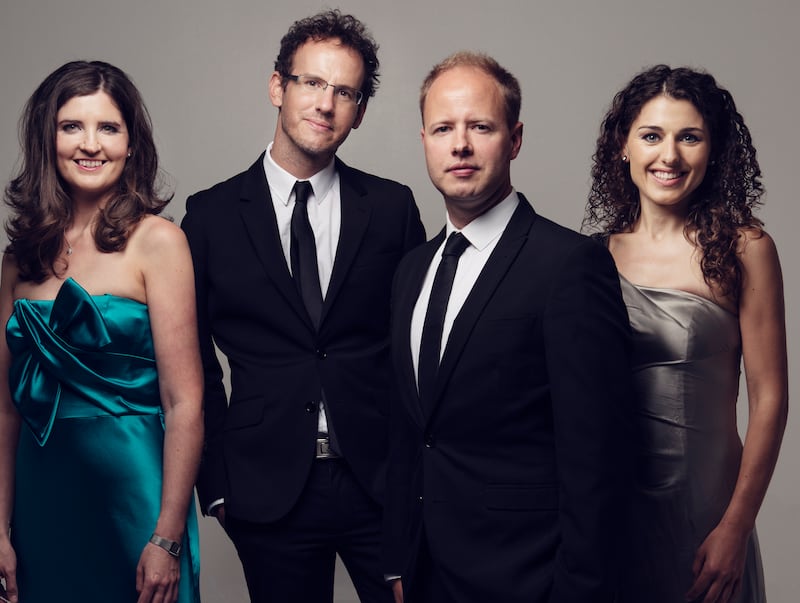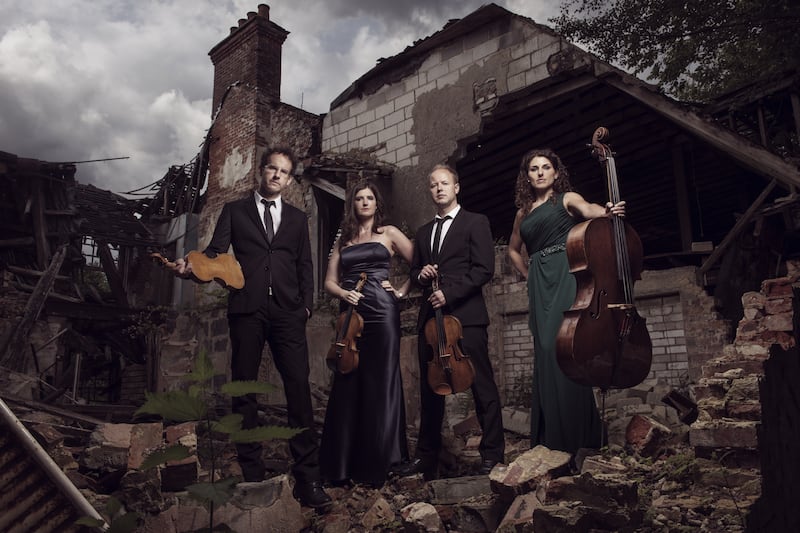A string quartet made up of two married couples is pretty unusual. The ConTempo Quartet, Galway’s ensemble-in-residence, is one. The half-Irish, half-English Carducci String Quartet is another.
For the Carducci, it’s less of a strain than you might think. Michelle Fleming, the group’s second violinist, who is married to its viola player, Eoin Schmidt-Martin, explains. “We’ve been in a quartet together as two couples for such a long time – since we were teenagers – I don’t think we know what it would be like to not be two couples. We’ve sort of just grown up with it. I think it would actually be stranger if we weren’t.”
Schmidt-Martin elaborates. “When we started going out, I was 17. We were already playing in a string quartet together, in youth orchestras together. We basically spent all of our time together over a long period. I’m in London working at the moment. That feels weird for me, whereas for most people it’s being in each other’s pockets all the time that would be unusual.”
[ Philip Glass: ‘Everyone needs a technique, whether they’re a plumber or a cook’Opens in new window ]
Emma Denton, the Carducci’s cellist, says, “In a way it’s incredible that all of our formative musical experiences have happened together, and that’s obviously shaped how we’ve grown as musicians.” Matthew Denton, the quartet’s leader, adds, “You’re totally living the string quartet, in many ways. There’s no escape from it. It’s bound up in your relationship and your life.” Everyone laughs when he says, “The only way out of this quartet really is a divorce!”
READ MORE
The musicians don’t seem to have experienced any downsides to the arrangement. They say they talk less and less during rehearsals, because they’ve got to know each other’s musical personalities so well. Emma Denton sums it up: “Yeah. Less talking, more playing. Definitely.”
It’s a process of ongoing development. Matthew Denton talks about “actors sometimes saying they need 50 performances of a play to get really comfortable”. He gives, as his own example, the second of Beethoven’s three Op 59 quartets, which are nicknamed Rasumovsky, after the Russian ambassador who commissioned them in Vienna in 1806. “For us, playing the second of the Rasumovsky quartets, particularly, the first 20 performances we were still a bit like, wow, this is extraordinary music but we still don’t really understand it – or even know, especially in the first movement, what the tempo should be.
“Another 20 performances and you start to feel like, okay. We’ve settled on a speed and we feel this is right, now. You get older, you’ve experienced life a bit more, and you understand a bit more about what Beethoven was going on about. Then you start to think, Okay, well, maybe the slow movement is more expressive now than we thought of it before. Who knows? Things change. It’s amazing to have that journey with music.”
Each of the four gravitated to the string quartet in their own way. Emma Denton was in a quartet from the age of eight, courtesy of her cello teacher, who was also her grandmother, and who would write a new quartet for the young group to play every week. A later cello teacher, Ioan Davies, made her learn and perform Shostakovich’s Eighth Quartet from memory, and lifted her to a higher level of intensity. Davies was a member of the Fitzwilliam String Quartet, which had worked on the quartets with the composer himself.
Matthew Denton never liked the exposure of being a soloist or the lack of flexibility of working in an orchestra. Chamber music was his metier. “Emma asked me to join her quartet. And once Emma asks, you can’t say no!”

Schmidt-Martin, who started on the violin, describes himself as the world’s worst practicer. At the end of every school year, he wanted to shelve the instrument. Then his teacher, John Vallery, introduced him to the viola. “It was a light-bulb moment. I just loved the sound of it.” And when he got to play string quartets, on one of the ConCorda courses set up by the Irish violinist Hugh Maguire and his wife, Trish, “A whole new world opened up – absolutely the most exciting musical experience of my life.”
Yet, in spite of all that, “After school I went and did a law degree. I had this fear that I should do something ‘sensible’. Of course I ended up being drawn back to music, and string-quartet playing was the black hole that kept sucking me in.”
Fleming says that “having the Vanbrugh Quartet in Cork” – in a long-term residency for RTÉ – “was inspirational. I heard their concerts so regularly. I still have such vivid memories of West Cork Chamber Music Festival, and hearing all the great quartets who would turn up in Bantry. The first job I did when I came out of college was the Carducci String Quartet. And here I am, 20 years later.”

The players convey a kind of collective contentment about their quartet experiences – four round pegs in four round holes. Emma Denton says, “I love the way that everything builds up from the bass. I feel like I really do have the ability to ground the group and to lead the dynamic momentum. As a cellist you have to have that focused bass sound for everything to build on. I’ve always enjoyed playing low down.”
Schmidt-Martin enjoys the fact that “on the viola you have to be a bit of a chameleon. I love those moments where you can really sing out, but also those moments where you’re the glue within the group’s sound.”
Fleming says second violin is more a personality type than a musical role. “Eoin always laughs at me, because when we’re in the car, and if there’s a song on the radio, I never sing the tune – I’m always harmonising. And I’ve done that since I was a little kid, without thinking about it. When I think about my role in the quartet, I think it was obvious, really. I just love those extra harmonies, and being in the middle of the texture rather than on the top. I never long to be the first violin.”
Matthew Denton acknowledges the extra burden that falls on leaders. “As the first violin you’re making a dedication to often incredibly difficult parts, and you know that it’s going to take a long time. Take, for example, Schubert’s Death and the Maiden string quartet. Emma and I might start practising it at the same time in the morning. I can hear her downstairs, working through it just as I’m working through it. And she’ll have got to the end while I’m still half way through the first movement. There’s just so much more technical stuff that I have to work on. It’s a time commitment, and you have to build up a certain amount of… confidence isn’t the right word, but a certain amount of thick skin, because you’re playing these difficult parts day in, day out.”
[ West Cork Chamber Music Festival: women’s work and a remarkable BeethovenOpens in new window ]
The reward is the greatness of so much of the repertoire he gets to work on. The name of Shostakovich, a composer whose complete quartets the group began performing as a cycle in 2015, crops up a lot. Schmidt-Martin recalls being coached in the Third Quartet at a master class in Bantry by Milan Škampa, viola player of the legendary Smetana Quartet. “He began the session by saying, ‘Oh, yes. Shostakovich 3. I played that 144 times from memory!’ Such a specific and bizarre thing to say. But there’s something so visceral about the music. It just haunts you.”
And there’s no escaping Beethoven. “His quartets feel like this mountain that we’re forever trying to climb, a journey we will continue to explore for the rest of our lives,” Fleming says.
For Emma Denton, “the Beethoven Rasumovsky, Op 59 No 2, that we’re playing in Kilkenny has definitely been a piece that’s generated the most exhilarating, incredible feelings you can have. It’s so intricate; it’s just weaving. And the first time it just works… I can’t describe that feeling. You get that from Beethoven in a way you don’t necessarily get from others. There’s something about the texture: it’s so difficult; even after hundreds of performances you still feel it. And Shostakovich is a real emotional punch for me.”
With Shostakovich, Matthew Denton says, “we found an even greater connection with audiences, somehow. People would say to us, the Haydn was nice. The Mendelssohn, oh, that was lovely. But the Shostakovich! Oh my God!
“The music should come with a health warning for performers. In 2015 we did 10 cycles, and at the end of it I felt so flat it was like I needed some anti-depressants. It was such an intense thing to go through. Beethoven, of course, is like the pinnacle.”
He also puts in a word for Debussy, Ravel, Piazzolla and Philip Glass (the last three featuring in Kilkenny), pointing out that Piazzolla and Glass studied with the same woman in Paris, Nadia Boulanger, one of the most influential composition teachers of the 20th century.
He also relates Beethoven to the quartet’s instruments, all with lineages of great musical and emotional significance for the players. “Over the last few years, when we’ve been trying out different instruments in the quartet,” he says, “that’s the music, the Beethoven string quartets, where you know if an instrument is a great instrument for a string quartet. You can find a lot of instruments that would sound quite good in Shostakovich and Mendelssohn. But there are a lot of instruments that don’t, then, work in Beethoven. It just needs such quality.”
He adds, “Someone was saying the other day, if you think of Beethoven, and the amount of music that he wrote, and yet you basically wouldn’t change a single note. How many contemporary composers can you say the same thing about, that in their complete works you wouldn’t change a note?”
The Carducci String Quartet play Haydn, Beethoven, Mendelssohn, Rebecca Clarke, Caroline Shaw, Dvořák, Philip Glass, Ravel and Piazzolla in lunchtime concerts at Kilkenny Arts Festival between Sunday, August 13th, and Wednesday, August 16th. The festival runs from Thursday, August 10th to Sunday, August 20th


















